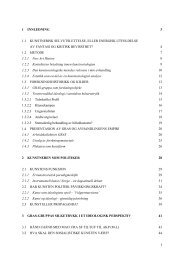2003 Rogaland museum - Gras Katalog - Victor Lind
2003 Rogaland museum - Gras Katalog - Victor Lind
2003 Rogaland museum - Gras Katalog - Victor Lind
You also want an ePaper? Increase the reach of your titles
YUMPU automatically turns print PDFs into web optimized ePapers that Google loves.
GRAS and the Political Reality<br />
Summary<br />
The political issues championed by GRAS related to the contemporary sociopolitical<br />
situation on many levels. GRAS as a group was interested in the democratisation<br />
of the Norwegian artists' union, the inexpensive production costs of art<br />
to assist in the spreading of art to the general society, the place of art in society, and<br />
the use of art as a political tool. The group also shared views on political issues such<br />
as the opposition to the Vietnam War. Contemporary criticism of GRAS' approach<br />
to the politicised image plays on the sense of naiveté and a lack of critical thought<br />
that permeates the work by the group. Without drawing attention to a comparison<br />
of historical and contemporary criticism, the politicised image can be reviewed<br />
through a contemporary analysis that draws on the problems associated with the<br />
historical transfiguration of the image and its import.<br />
Three different situations can be identified in this light. Firstly, the image<br />
that has successfully transformed its political subject matter through the import of<br />
the work of art has simultaneously achieved status as symbol. Per Kleiva's<br />
Amerikanske sommarfuglar exemplifies this as the work of art is at once symbolic<br />
of its political import without the burden of being bound by its historically based<br />
political elements. Secondly, images that utilise elements in the construction of the<br />
composition – without necessarily becoming 'art symbols' in their own right – are<br />
at risk of losing touch with the reference point from which the work is developed<br />
when, over time, those elements become weakened. Such examples include images<br />
of immortalised figures that persistently retain the ability to refer to their meaning.<br />
Thirdly and lastly, images like those that played on existing icons to construct<br />
import have not always been equally successful in establishing the longevity of the<br />
image. The most prominent example at hand is Per Kleiva's Helsing til Ho Chi Minh<br />
where, as a commentary on the political situation of the times, FNL’s revolutionary<br />
flag and a lotus flower are united to present a simple, yet complex image.<br />
Once the symbols, however, begin to lose their symbolic meaning, the foundation<br />
of the work is shaken and the image must be established on another level or<br />
risk losing its significance. The importance of this is linked to an understanding of<br />
these works, with regards to their art historical and political significance and with<br />
regards to their contemporary readings, highlighting both their shortcomings and<br />
achievements.<br />
27



